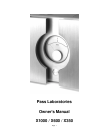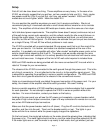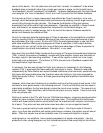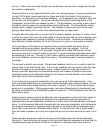Page 4
the front panel stand-by button to go to stand-by mode, with the meter light off and the meter
parked to the left.
OK, so the amplifier is sitting there in stand-by mode with just the single blue led lit. No
speaker connected yet. You can go ahead and connect the source now.
The amplifier requires a fully balanced source, that is to say a male XLR connector with pin 1
at ground, pin 2 positive signal, and pin 3 negative signal. Both pins 2 and 3 should be driven
by equal levels of signal with opposite phase.
In standby mode, the balanced inputs to the circuit are shorted, and the input impedance of the
amplifier will be 2000 ohms, just so you know.
Now that the source component is connected, make sure there is no signal coming from it,
probably by turning the volume all the way down.
The next step is the connection of the speaker. If this is the first time out of the box with the
amplifier and you are particularly paranoid, you might connect up some cheap disposable
speaker first, but I have to say that we have not seen a failure yet, and are not expecting one.
On the X1000 and X600 the two sets of output connectors on the rear panel are in parallel, for
the convenience of those who wish to bi-wire their loudspeakers. The red terminal is
connected directly to the other red terminal, and so with both black terminals.
On the X350, there is one set per output, but the terminal should be large enough to
accommodate dual spade lugs if desired.
With the speakers connected, push the front panel button to activate the amplifier. The meter
lights will come on. The meter on the front should go to somewhere between one-third and
half way up, reflecting the bias on the output stage.
You are ready to play music.
The meters read current through the output stage in the X1000 and X600 and total supply
charging current in the X350. At low levels, they should stay pretty constant and if the meters
are bouncing around at a moderate or low listening level, it might indicate that you are driving a
very low impedance load or even a dead short. If your speakers are not known to be very low
impedance, say less than 4 ohms, then you should check this out.
Do everybody a favor and try not to have shorted output cables. It happens accidentally all the
time, and the amplifier is designed to survive, but I wouldn’t bet the farm on it.
With the X350, you will see some meter bounce if the AC line is not constant. This is normal,
and simply shows the different charging rate of the power supply capacitors, not the actual
current going through the audio circuitry. You will also note on the X350 that the meter shows
the draw of both channels. We had only one meter.
Of course it’s always possible that something could go wrong. If so, don’t get excited, just
relax. It’s really aggravating when something like this doesn’t work, we understand, but it will
get fixed. At Pass Labs, we go to a lot of trouble to make products reliable, and the failure rate


















